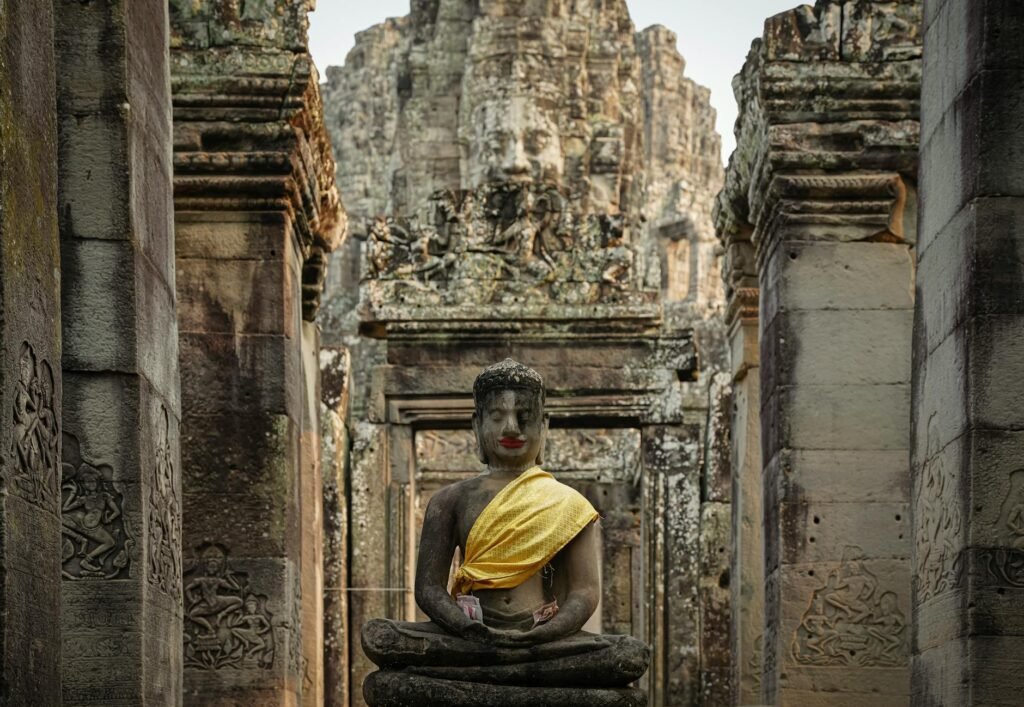Embark on an unforgettable journey to explore the magnificent Bayon temple, a masterpiece of Khmer architecture nestled within the sprawling Angkor Thom complex. This awe-inspiring temple, renowned for its enigmatic smiling faces carved into its towers, beckons travelers from around the globe to delve into its rich history and captivating beauty.
A Glimpse into History
Construction of the Bayon temple commenced in the late 12th century during the reign of King Jayavarman VII. Originally serving as the state temple of his capital, Angkor Thom, the Bayon stands as a testament to the Khmer Empire’s artistic prowess and spiritual beliefs.  Learn more about the fascinating history of Angkor Thom and its significance to the Khmer civilization.
Learn more about the fascinating history of Angkor Thom and its significance to the Khmer civilization.
The Enigmatic Smiling Faces
Undoubtedly, the most striking feature of the Bayon temple is its countless bas-reliefs depicting serene, smiling faces. These enigmatic expressions, carved into the towers and gallery walls, continue to captivate and inspire interpretations. The exact meaning remains a mystery, fueling scholarly debates and adding to the temple’s allure.  Discover more about the mysteries of the Bayon’s faces on this excellent external resource.
Discover more about the mysteries of the Bayon’s faces on this excellent external resource.
Exploring the Temple’s Layout
The Bayon’s layout is complex and fascinating. It features three concentric galleries with intricate carvings depicting scenes from Hindu epics and everyday Khmer life. Navigating through the temple’s labyrinthine passageways and towering structures is an experience in itself. Take your time; exploring every nook and cranny is highly rewarding. You can find more detailed information about the temple’s layout in this architectural guide.
The Central Towers and Their Significance
The central towers of the Bayon, each adorned with the iconic smiling faces, represent Mount Meru, the mythical home of the gods in Hindu cosmology. The intricate carvings on these towers depict scenes of religious rituals, battles, and daily life. Climbing to the upper levels (where allowed) offers breathtaking panoramic views of the surrounding jungle and other temples. [IMAGE_3_HERE] Don’t forget to check out our guide to Angkor Wat, another stunning temple nearby.
Practical Tips for Your Visit
Plan your visit during the cooler months (November to March) for the most pleasant experience. Remember to dress modestly, wear comfortable shoes, and bring plenty of water. Consider hiring a local guide to enhance your understanding of the temple’s history and significance. For more information on what to expect and how to plan your trip, check out this travel blog.
Remember to protect this historical site by adhering to all guidelines. Consider purchasing a ticket to support its preservation. Read about the responsible travel guide for Angkor for further details. [IMAGE_4_HERE]
Conclusion
A visit to the Bayon temple is an unforgettable experience that transcends the realm of mere sightseeing; it’s a journey through time, art, and spirituality. The enigmatic smiles, intricate carvings, and imposing architecture leave a lasting impression, prompting reflection on the power of human creativity and the mysteries of the past.
Frequently Asked Questions
What is the best time to visit the Bayon temple? The best time to visit is during the dry season, from November to March, for pleasant weather.
How much time should I allocate for exploring the temple? Allow at least 2-3 hours to fully explore the temple’s many galleries and towers.
Can I take photographs inside the temple? Photography is generally permitted, but check for any restrictions in specific areas. Remember to be respectful of the sacred space.
Are there any guided tours available? Yes, guided tours are readily available, offering valuable insights into the temple’s history and significance. These are highly recommended.
What is the cost of entry? The cost of entry is usually included in the Angkor Pass, which covers multiple temples within the Angkor complex. Check the official website for the most up-to-date pricing information.